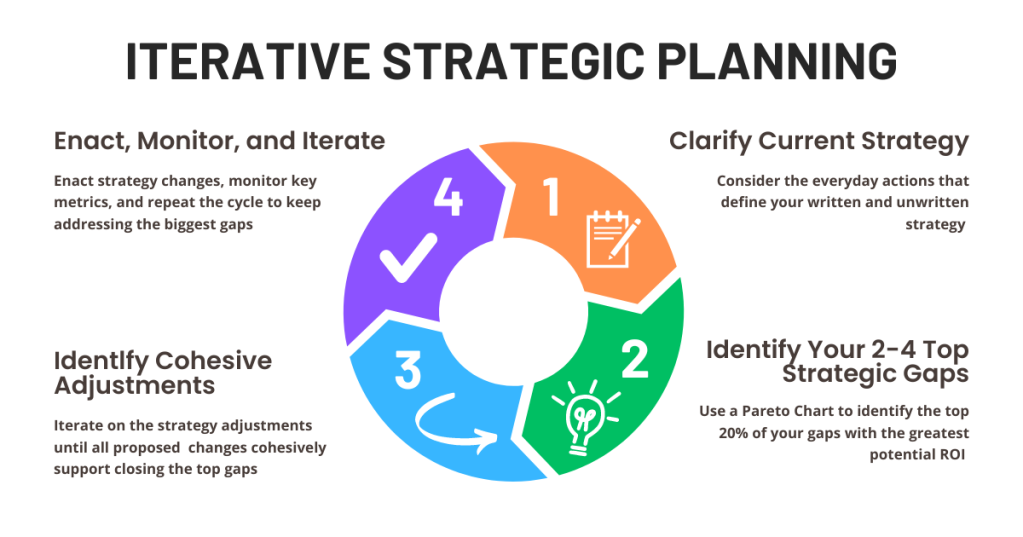
In the tech world, organizational strategy often seems like a permanent fixture on the drawing board, constantly updated every year or two with shiny new plans that promise the moon… usually just as everyone has gotten the hang of the last plan. This frequent shake-up can leave everyone running in circles, which is pretty exhausting, isn’t it? What if there was a way to approach strategy that focuses on genuine improvement rather than just change?
To start, it’s worth acknowledging that every organization operates with a strategy, even if it looks nothing like the polished presentation from last year’s retreat. Your true strategy is shown in your actions, not your words. It’s in every decision you make, every budget you approve, and every market you enter. Often, there’s a big gap between what’s said and what’s done, and this is where many strategies fall apart. When the grand plans don’t seem to pay off, the knee-jerk reaction is to scrap everything and start over. Yet, I’ve noticed that the companies that take the time to understand what’s working and then build on those successes tend to fare much better in the long run.
In rethinking your approach to strategy, the first step is about understanding what’s currently at play in your organization. Start by taking a good, hard look at the strategies you’ve rolled out. Which ones are delivering as promised? Which seem to be just going through the motions, not really hitting the mark? What are the unwritten rules that people are actually following? Getting a clear picture of what’s working and what isn’t forms the foundation of where you need to focus your efforts next.
Once you’ve got a clear view of your current strategy, whip up a Pareto chart to zero in on what most needs your attention. You’ll probably notice that about 20% of the issues you’re running into are actually driving 80% of your results. This neat statistical trick helps you streamline your decision making and focus your resources on creating the biggest positive change with the least amount of effort. Plus, it’s a clear, visual way to show your team exactly what matters most. As a general rule, this means you’ll pick the top 2-4 gaps the chart calls out.

But hold on! Before you dive into making any changes to the strategy, do a bit of pressure testing to ensure that all the adjustments you’re considering for each gap will actually play nice together. This is often where strategic planning often falls short, especially if there isn’t a cohesive vision at the top of the organization. Sometimes, closing one gap can unintentionally twiden another. A very common example is where the staffing required to shift into a new market might steal the people you need to provide additional support to your current market.
So, start with your biggest gap and consider what changes might help. Then, tackle the second gap with a similar approach. But before you move on to a third, take a look back at what you’ve planned for the first two. Are these changes going to conflict or are they working together in harmony? Does your strategic change just create different large problems for the future?
Once you’re sure that the changes to the first two gaps are in sync, then you can figure out the best approach for the third gap. Use the same method of forecast what might happen to the first two gaps if you make changes to improve the third. If you spot any potential issues, don’t hesitate to revisit and revise your plans. Repeat if you have a fourth gap you’re also focusing on. Continue adjusting and testing until you have a cohesive set of strategies.
With a solid plan in place, the real work begins. Implement your strategic changes and keep an eye on the metrics that matter—the ones that directly speak to the gaps you’re trying to close. As you see improvements, or if certain gaps aren’t closing as expected, be ready to iterate on your strategy. This ongoing process of monitoring, adjusting, and refining helps you adapt to the changing landscape and continue to close the biggest gaps.
In the end, strategy is about the smart everyday choices, not the grand declarations or massive overhauls every few years. It’s those continual improvements, making sure that every decision is moving us closer to our goals. That’s how real progress is made—not through the noise of big strategic shifts, but through the quiet, consistent tuning that keeps us on track

Leave a comment